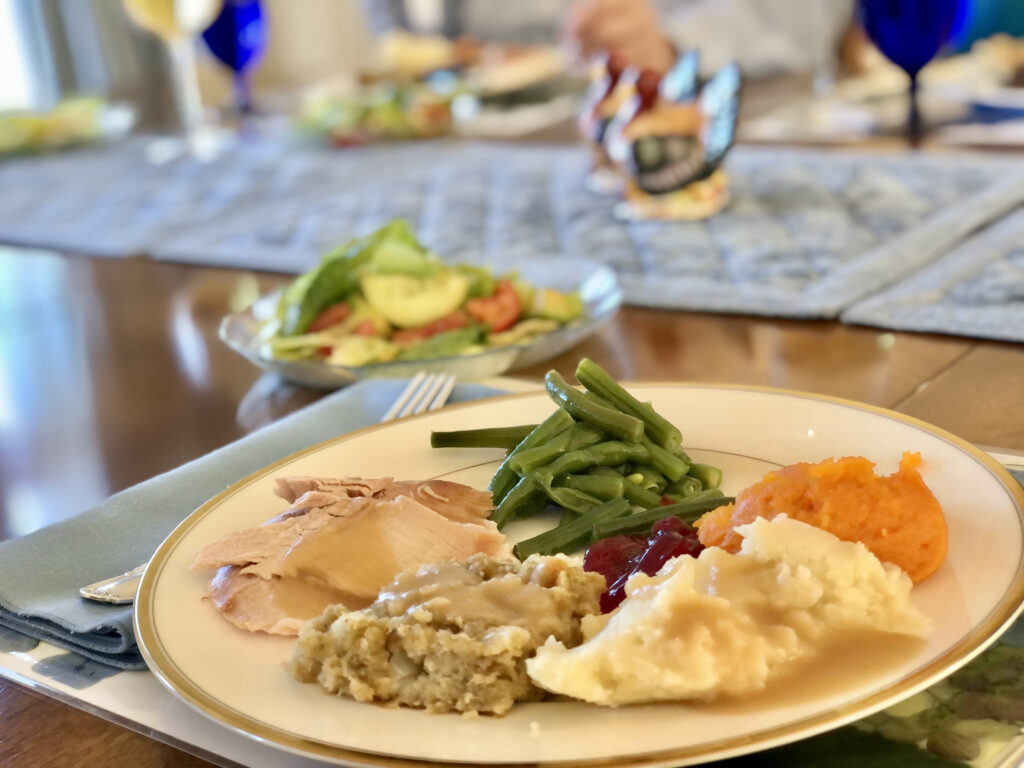“How to Optimize Time-Restricted Eating / Intermittent Fasting”
~ Helpful or Impossible Strategy for the Holidays!
Anne Till, MNutr, RDN, LDN

The holidays are upon us and with these festivities come multiple opportunities to “eat, drink, and be merry”. For some of us, this time can be challenging as we continue to work on our health goals. I have had many people ask me about Time Restricted Eating (TRE) also known as Intermittent Fasting and how helpful it can be as a strategy for weight and health management, so I decided to post a blog post on the subject with recommendations on how to get the most out of this approach during the holiday season and at other times of the year.
What is Time Restricted Eating (TRE)
TRE is an eating pattern that focuses not specifically on what you eat, but when you eat. In TRE, you designate a specific window of time each day—often between 6 and 10 hours during which you consume all your meals and snacks. Most commonly people choose to have an 8-hour eating window. Outside of this window, you abstain from eating, allowing your body a period of fasting. This approach is believed to offer a variety of health benefits. For example, limiting your eating to a certain time frame can make it easier to manage caloric intake, potentially aiding in weight loss or maintenance. In addition, having a period of not eating during a day allows for lower circulating insulin levels when “fasting” which supports the body’s ability to use fat as a source of fuel. Research also suggests that TRE may improve insulin sensitivity and reduce inflammation. These factors contribute to better metabolic health, which is a cornerstone of overall wellness. By aligning your eating habits with your body’s natural circadian rhythms, time-restricted eating may support a holistic health journey.
Are there Concerns about TRE?
While time-restricted eating (TRE) has gained attention for its potential health benefits, it’s important to consider it may have some drawbacks and limitations.
One of the most significant challenges of TRE is that it can interfere with social events, family meals, and other activities that don’t align with your eating window. This limitation can sometimes be socially isolating or stressful, especially during holidays or special occasions.
Another concern with a restricted eating window is that some people may find themselves eating larger meals or choosing high-calorie, nutrient-poor foods in an attempt to feel satisfied, which could negate the benefits of calorie reduction and lower circulating insulin levels.
Another important consideration is that TRE may not be appropriate for everyone, especially those with certain medical conditions like diabetes, or for pregnant or breastfeeding women. It’s also generally not recommended for children or adolescents who are still growing, or for individuals with a history of eating disorders.
Is TRE an eating strategy you should consider adopting during the holiday season? Or if you are already applying the concept of TRE to your daily eating pattern – then is this something you should continue to do over the holidays?
The discussion that follows may help you to decide if TRE may be helpful to you and how to apply the principles to get the most out of TRE recommendations.
TRE is Not a Diet
The first thing to note about TRE is that it is not a diet or a nutritional strategy that supports a better nutrient intake. It is a way of eating to manage one’s eating habits and to facilitate lower circulating insulin levels at least for 12 to 16 hours daily to support metabolic goals of improving insulin sensitivity and healthy weight management.
Because TRE does not give specific recommendations on what you should eat or even the exact time that you should eat within your eating window, it can not be considered a comprehensive approach to managing food intake or supporting healthy eating habits. It is not a solution that ensures optimal nutrition or even a healthy relationship with food. But it is still a very useful tool if you can get the balance right.
TRE Recommendations
When I have patients who choose to follow a TRE eating pattern I give them the following recommendations.
Your Eating Window Needs to Work for Your Goals
Don’t make the eating window too short and don’t make the fasting window too long. One of the greatest and most powerful stimulators of appetite is low blood sugar and extended periods of fasting. Nonetheless, it is completely acceptable to have periods during the day when you do not eat. Just like it’s acceptable and actually highly desirable to have periods of the day when you’re awake and periods of the day when you are sleeping. And, just like wakefulness and rest, it is appropriate to have a time during the day when you eat and a time during the day when you don’t eat. In our modern-day environment, it is not uncommon to find that food is available all the time and around the clock. This means that you could start your day very early by eating breakfast before sunrise, and continue to snack into the late evening while watching your favorite Netflix show. TRE allows you to ring-fence your eating window and in doing so cut out unnecessary snacking in the late evening which may even result in you skipping that very early morning breakfast because you’re not often hungry at this time. TRE can support your health and weight management goals providing that you don’t push the concept too far and as a result lose control of your appetite and spur on unnecessary and unwanted food cravings. In order to prevent TRE from doing this it is necessary for you to be realistic about your time eating window as well as the period of “fasting” that works for you. A 16 hour fasting window and an 8-hour eating window seem to work for many people. However, others are more comfortable with a 10-hour eating window and 14 hours fast. A dietitian can help you decide what may work best for you based on your goals and needs.
The Nutritional Quality of Food Still Matters
The next thing that I recommend to my patients who choose TRE is that they don’t abdicate responsibility with regard to the nutritional quality of food consumed. This means that you should not rely solely and entirely on the concept of TRE to support your health goals. Given that the nutrient needs of your body are met through food, it is necessary to embrace healthy food behaviors too as part of your TRE eating pattern. This simply means that when your eating window starts you commence eating healthy foods that will also support your metabolic and nutrient goals.

Make the First Meal of the Day Fulfilling and Enjoyable
The next bit of advice that I give patients is to make the first meal of the day count to support improved appetite control. To this end, it is highly recommended that the first meal eaten after breaking your fasting window is one that is fulfilling, tasty, and contributes all macronutrients including carbohydrates, proteins, and unsaturated fats, as well as other nutrients such as fiber vitamins, and minerals. An example could be a breakfast omelet filled with sautéed peppers and onions a side of mushrooms and a side serving of fresh fruit. Another example could be a delicious grain bowl served with whole-grain quinoa, pickled onions, leafy greens, edamame beans, grilled chicken pieces, and avocado, drizzled with a little olive oil and/or dressing. The goal is to make sure that your first meal of the day makes you feel satisfied physically and emotionally. This first meal choice will set you up for success and result in a reduced need for snacking during the day. If the first meal of the day is not nutrient-rich, or high enough in food volume, then you could be left with food cravings and a hunger that is not satisfied which can result in continuous snacking for the remainder of the eating window.

Time Meals within your Eating Window
Another suggestion is to apply the concept of TRE not only to the eating window but also to the times that you eat within the eating window. For example, if the first meal of the day is at 10 AM, it is important to make sure that you have a gap between the first meal and the next meal/snack. For example, if breakfast is at 10 am, then lunch may be 4 hours later at 2 pm and then dinner may be another 4 hours later at 6 pm. Between meals, it is important to monitor the snacking habits as well as the quality of the food eaten. Allowing insulin levels to drop between meals can offer an additional advantage.

Portions and Proportions offer additional Advantages to Your Health
On top of considering the quality of the food and the timing of meals, it is important to consider the portion sizes of meals, and the proportions of foods that are consumed. For example, in TRE a person may consider that pizza could fit into the eating plan, and it can, however, if one includes the entire Pizza – the overall spike in insulin and calorie intake as well as the unbalanced proportions of nutrients will not serve a person’s health or metabolic goals. It is important to keep in mind that portion control and the proportions of food remain important. At meals, it is a good idea to include a source of protein, good quality low glycemic carbohydrates, unsaturated fats, and high-fiber foods such as vegetables or salads(half your plate) to support nutrient intake, lower insulin levels, and improve feelings of satiety that translate into improved appetite control and better overall health. (Plate)
How to apply the concept of TRE to the holidays and can this be helpful or simply frustrating?

It is possible to apply the principles of TRE to the holidays, however, you have to have a clear understanding of when you will be eating so that you can slide your eating window up or down during the day to suit your social calendar. For example, if you tend to eat your Thanksgiving meal later in the day, then start your eating window a little later in the day. It is still recommended however that you do not attend an event when you are absolutely starving as it’s very difficult to control food intake when you’re overly hungry. It’s also recommended that you consider the types and amounts of foods consumed at the holiday feast. This does not mean that you should not enjoy yourself. It means that you should choose the foods that you would like to eat in appropriate amounts. Then make sure that you eat slowly, savor each bite to get the most enjoyment out of the food selected – and turn your focus to being social which is an important component of holiday festivities. Similarly, if your eating window starts earlier in the day- you can end it earlier too.
Keep these recommendations in mind over the Holiday Season to support your success.
- Don’t make the eating window too short and the fasting window too long
- Choose nutrient-dense, high-quality foods as far as you are able to
- Make the first meal of the day count – to support appetite control, and nutrient intake and reduce the need for snacking.
- Be mindful of the times you are eating within your eating window – pre-decide what you will do for a specific day and holiday festivity
- Monitor portion sizes and proportion of food selected at holiday meals or celebrations
- If you find it difficult to stick to your pre-decided eating window at a specific holiday celebration – that is ok – be flexible, and avoid catastrophic thinking that can really sabotage your goals and your belief in your ability to continue your health journey after the holiday festivities. Remember TRE is a tool – there is no pass or fail grade.
How can a Dietitian help with TRE?
A registered dietitian offers invaluable expertise for those adopting a time-restricted eating (TRE) plan. Beyond just setting an eating window, they provide a personalized approach tailored to your health needs, lifestyle, and dietary preferences. Dietitians guide you in choosing nutrient-dense foods and mastering portion control, ensuring you get essential vitamins and minerals. They also help align your TRE schedule with your daily routine and social commitments, offering regular check-ins for plan adjustments and accountability. Their comprehensive guidance optimizes your metabolic health and makes your TRE journey more effective and sustainable.
Take away message
Time-restricted eating (TRE) can support weight management and metabolic health when aligned with circadian rhythms. However, it’s not a one-size-fits-all solution and requires flexibility, especially during special occasions. TRE should complement, not replace, a balanced diet focused on nutritional quality, portion control, and meal timing. Consulting a registered dietitian can offer personalized guidance to tailor TRE to your individual needs, enhancing its effectiveness and sustainability in your overall wellness journey.
For more information reach out to us – we are here to help you Click here
Call Us Today: 919-990-1130







